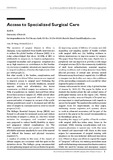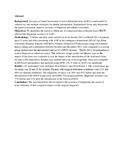Search
Now showing items 31-40 of 50
The pattern of external laryngeal nerve relation to the superior thyroid artery in a Kenyan population
(University of Nairobi, 2013)
No Abstract
Cellular polypropylene‐based piezoelectric films
(University of Nairobi,, 2012)
Cellular polypropylene-calcium carbonate based piezoelectric films were obtained using biaxial stretching and gas-mediated inflation followed by a corona discharge treatment using home-made devices. The obtained results ...
Preliminary data from a de novo trauma registry
(2016)
Background: Trauma remains a significant cause of morbidity and mortality globally. Trauma registries are a key component of trauma systems in developed countries which have promoted improvement of patient care and outcomes. ...
Establishing hospital-based trauma registry systems: lessons from Kenya.
(University of Nairobi, 2013-12)
OBJECTIVE:
In the developing world, data about the burden of injury, injury outcomes, and complications of care are limited. Hospital-based trauma registries are a data source that can help define this burden. Under the ...
The effect of a knowledge-based ergonomic intervention amongst administrators at Aga Khan University Hospital, Nairobi.
(University of Nairobi, 2015-08)
BACKGROUND:
Low back pain (LBP) and neck pain are part of the common work-related musculoskeletal disorders with a large impact on the affected person. Despite having a multifactorial aetiology, ergonomic factors play ...
The Role of Infiltrative Local Anaesthesia in Thyroidectomy
(College of Health sciences, 2013)
Background: General anaesthesia is the anaesthetic agent of choice during thyroidectomy, however, recent reports there is a role for local anaesthesia. This study reports on the experience of thyroidectomy performed under ...
Does a Structured Data Collection Form Improve The Accuracy of Diagnosis of Acute Abdomen in an Urban Private Hospital?
(College of Health sciences, 2013)
Background: Accuracy of initial assessment of acute abdominal pain (AAP) is confounded by subjectivity and multiple etiologies for similar presentation. Standardized forms may harmonize the initial assessment, improve ...
Evaluation of POSSUM and P-POSSUM as predictors of mortality and morbidity in patients undergoing laparotomy at a referral hospital in Nairobi, Kenya
(2010)
The Physiological and Operative Severity Score for enumeration of
Morbidity and Mortality (POSSUM) and its Portsmouth modification
(P-POSSUM) were developed for comparative audit in surgical patients.
This study evaluated ...
Nine-point plan to improve care of the injured patient: A case study from Kenya.
(University of Nairobi, 2017)
BACKGROUND:
Injury rates in low- and middle-income countries are among the greatest in the world, with >90% of unintentional injury occurring in low- or middle-income countries. The risk of death from injuries is 6 times ...







